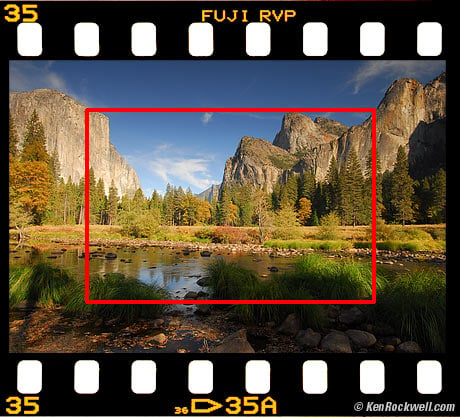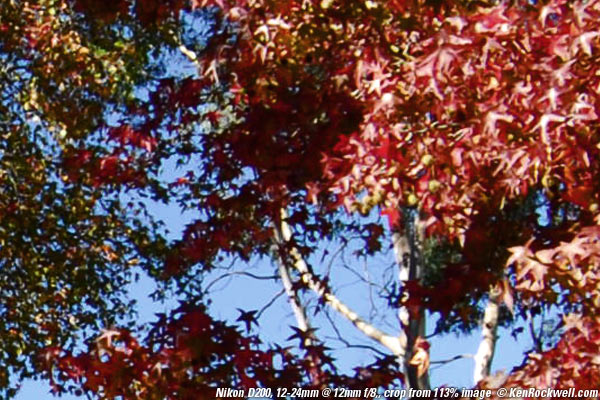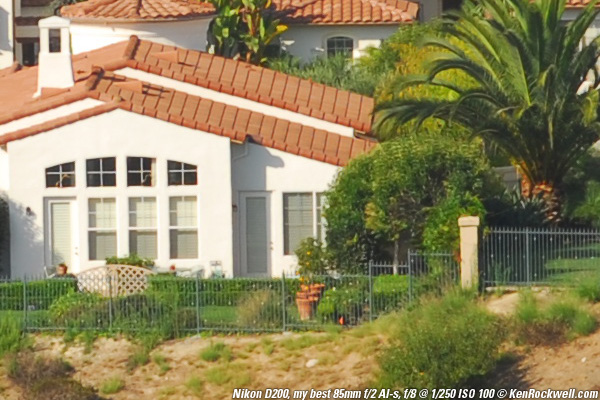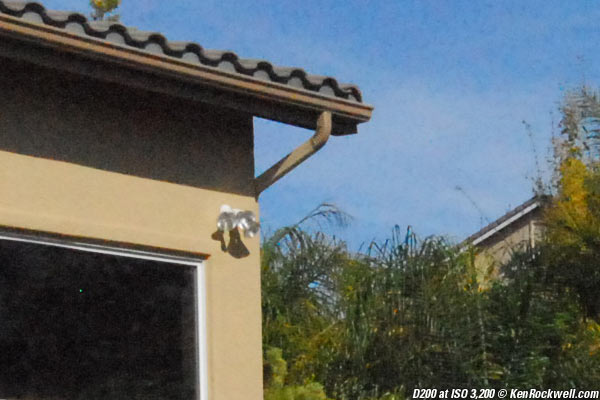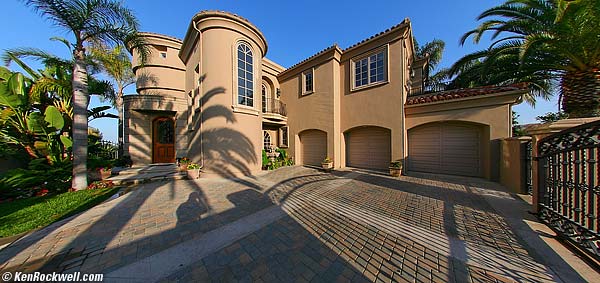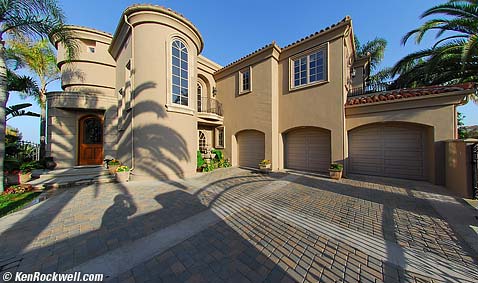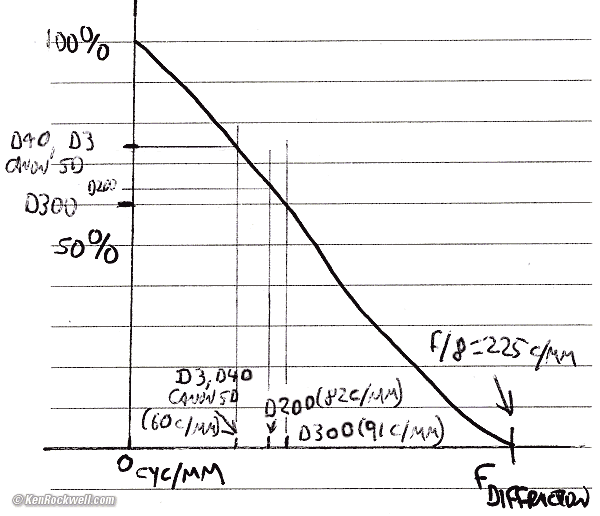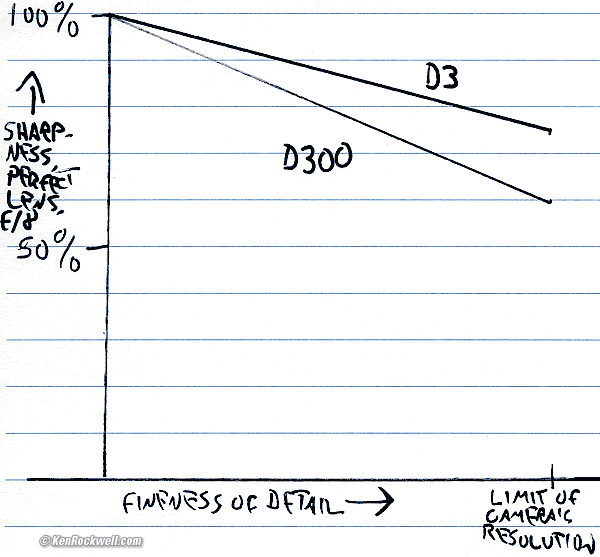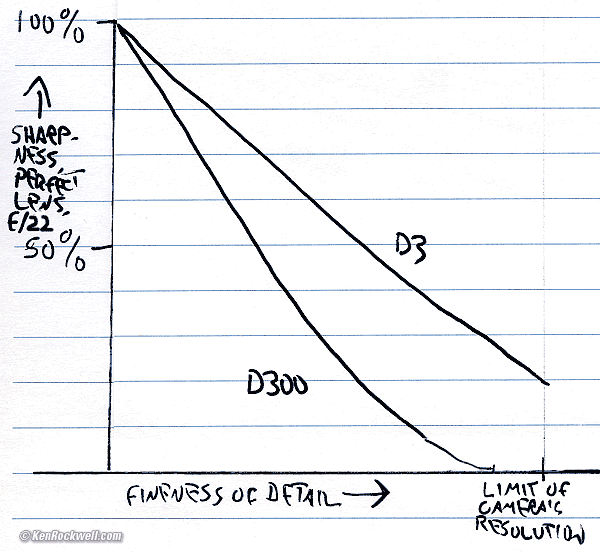Home Search Gallery How-To Books Links Workshops About Contact
|
The Full-Frame
The red rectangle shows the crop factor of a DX Nikon. I get my goodies at Ritz, Amazon and Adorama. It helps me keep adding to this site when you get yours from those links, too. September 2007 WARNING: If you just want to make great photos of things that matter, don't worry about this baloney and get whatever you find convenient. I use my D40 and its kit lens or my 18-200mm VR 90% of the time for my photos that matter. In the few rare cases that something will sit around and wait for me, I'll pull out my klunky Canon 5D or 4x5" view camera. I haven't had my 4x5" fired up in over a year, but I use my D40 daily, and even when my D3 arrives, I expect that I'll still use the D40 most of the time. The D40 is easier and more fun since it's so light. The only way to see any of these pixel differences is when you've already got a flawless shot, and then only when printed really big and you're looking too closely. Don't start counting pixels until you can make the right pixels. I was an idiot and wasted my first 15-20 years of shooting worrying about the wrong things, like resolution instead of color. This is why I so strongly caution you not to get caught up in this foolishness. This article, like many of mine, deals with minor technical issues. These fine points are only significant after all the far more critical basics of location, composition, lighting, timing, color, tone and gesture have been mastered. Worrying about minute details like noise and resolution before you know how to make a good photo will ensure you never learn enough about the important issues to make great photos. If you'd like to learn how to make great photos, don't bother with these technical articles, instead read good books or take a local photo class. Your camera doesn't matter if you know what you're doing, and if you do know what you're doing, a better camera just makes it easier to get the results you demand. If you count pixels photographing brick walls from a tripod, you'll love any larger format camera, digital or film. If you just want great photos, get whatever you want and won't get between you and a great shot. INTRODUCTION I'm overjoyed that we now have a choice of format in the Nikon digital system for which most of you people read this site. Personally I've been shooting larger film formats for decades, and Canon Digital for a year and loving it, so it's great that I now can share this without anyone having to jump sytems. Back in 1991 my company won an Emmy Award. The 8 x 10" (20 x 25cm) publicity photos of our award statue were amazingly clear, sharp, smooth and colorful. I got great shots on my 35mm Nikon back then, and made razor-sharp 20 x 30" (50 x 80cm) prints from my Velvia slides, but somehow even these little 8x10" prints had some intangible magic quality to them. I asked my art director, Pat Neill, what was up. He said "elementary: those were shot on a 4x5" camera." Hmm, as an engineer back then I couldn't figure out how it could make such a huge difference for such small prints. Years later I figured out the engineering reasons why a bigger piece of the same film could give better color as well as sharpness, but it still makes little sense to most reasonable people. I started shooting 4x5," and was astounded at how my crappy scratched 1940's Wollensak lens on my old Crown Graphic made images so technically beyond anything any of my best Nikons could do. Ever since 1991 I've looked for the smallest possible camera that shoots the largest possible piece of film or digital sensor. For me, that's my cheesy Tachihara 4x5, the Mamiya 6 or Mamiya 7 medium format cameras, and a Canon 5D full-frame digital. After years of pondering how to explain why larger formats just look so much better, let me share my discoveries. Of course more important than any technical dithering is simply to go look at the images. That's what sold me in 1991. In film formats, each format is about double the dimensions of the next format, or four times the area. This is a huge and obvious difference. In digital with 1.6x or DX vs. Nikon FX or Canon full-frame, the difference is only 1.5x on one side, or about double the area. It's still enough to make a big difference if you're looking closely. Small-format DX and 1.6x DSLRs were ideal for digital SLRs up to about 6MP back in the dawn of digital photography. By about 10 MP in small formats, most of the extra pixels today are splitting up the limitations of your lenses (and our own photo abilities) into smaller pieces instead of showing us more detail. Having more pixels on a small format doesn't make a sharper picture if all these extra pixels are doing is splitting up a lens' limited resolution (or subject motion or limited depth of field or small-aperture diffraction) into more pixels. This is a funny article. Many people write all sorts of crazy unfounded things hypothesizing about why something they've never seen might happen one way or another. In this case, I've seen these real effects for decades, and been seeing it in digital ever since I got my full-frame 5D in 2006, and am writing this to attempt to explain the very real results I hope I show in a few examples. Feel free not to read anything and just look at the examples. I was stunned a year ago when I first saw this! I've never heard 4x5" shooters worry about lens sharpness or film grain (noise) because we have no problems. Film grain, lens and film sharpness used to be all 35mm shooters discussed, because smaller formats have these problems. If you worry about these things, do yourself a favor and step up to full frame digital. I didn't push this point back when Nikon only made DX cameras, but now that NIkon makes the D3, I don't want to hear any more whining about noise or sharpness from people who use smaller format digital cameras. If you worry about it, get a full-size camera and stop complaining. Sharpness back to top Crops from 100% camera-direct images from full-frame Canon 5D vs. Nikon D200 (DX). Roll mouse over to compare. These images would print 43" (1.1m) wide at this magnification. Sharpness is how sharply all details, regardless of their fineness, are rendered. Sharpness is a much more complex issue than a simple resolution number. See what's going on in the rollover images above? It's a lot more than the 14% difference in linear pixel count between these two cameras. Why is that? Resolution is measured by counting pixels, or by looking for the very finest detail that can be resolved. At the rated resolving power, usually expressed in lines per some unit length, the sharpness has fallen to zero. Whoops! As artists and photographers, we don't care where the sharpness falls to zero, which means you can't see it. Our images depend on the sharpness of details we can see, which are much coarser details than the limits tested and specified. Feel free to see my MTF graphs at the bottom for a technical explanation of why larger formats look so much sharper than smaller ones, even if they have the same resolution. Also see solid examples in my 16mm Zenitar Fisheye Review, where this crappy Russian lens on full-frame completely outperforms my new Nikon 10.5mm DX on a DX camera as I stop them both down. The simple explanation is that we don't have to enlarge larger formats as much, which makes lens performance much less important. Even at much less than the limits of resolution, practical lens performance is much better with larger formats because the lens doesn't need to resolve as much as sharply to give the same great, or better, image. You Can Use Cheap Lenses! I get better results on full-frame with crummy lenses than I do with my very best lenses on DX. Having bigger pixels on a larger format means you can use cheaper lenses and usually get better results than the best lenses on a smaller format. The only reason I use the weasel word of "usually" is because as of 2007 we're only talking about a 1.6x linear format difference among consumer (under $9,000) DSLRs. In film, with a 2x linear difference from one format to the next, the crappiest lens on the next bigger format always smokes the very best lens on the next smaller format. Cheap lens on full-frame vs. my best lens on DX. (roll your mouse over) Above are crops from much larger images at 100% shot on my Canon 5D full-frame with a 20-year old Canon EF 70-210mm f/4 zoom lens and shot with my very best lens in this range, my Nikkor 85mm f/2 AI-s, on my DX D200. If you printed the complete images at this magnification, they'd be 43" (1.1m) wide. I was shooting from about a quarter mile (400m) away. My zoom was set to 120mm on full-frame to give a slightly wider view and to give the Nikon an unfair advantage. The Canon has slightly more pixels, so I set my lenses so the same angle of view covered the same number of pixels. This way they'd be similar when cropped at 100%. I came pretty close. 120mm is only 1.41x 85mm; I could have shot the 5D at 129mm and rescaled to make it look better, but that's not the point. In case you want to try this yourself, I used these settings to get the colors and tones to match this closely between camera brands: Nikon D200: Large Norm JPG, optimum quality, Auto -2 WB, -1/3 exposure compensation, + saturation, color mode III. Everything else was on default. Canon 5D: JPG normal (not fine), AWB, sharpness 3 (default), saturation +3. Everything else was on default. Both file sizes were 3.4MB. Any test like this can have many outcomes. This is to show how great a cheap lens can look on full frame compared to the very best possible lens on DX. If I used better lenses on my Canon, the results would be even more different as I showed with the trees above. I could sharpen this D200/excellent lens image to look almost as good as the 5D/cheap lens image, but then again, I could have used a really good lens on the 5D, like my 70-200mm f/4L IS, and used a softer zoom on my D200, like my excellent, but less sharp 80-200mm f/2.8 AF-S, or my much less sharp (for tripod tests) 18-200mm VR. I tried every lens to find my very best Nikkor to put up against my crappiest old Canon full-frame lens in this range. My apologies, I didn't have any other crappy Canon lenses. I was astounded when I discovered that a cheap $175 Russian fisheye on my 5D gave better image quality than my brand-new 10.5mm Nikkor on my D200. See the comparison in my Zenitar 16mm Fisheye review. When my Nikon D3 shows up this will be much more interesting and relevant to show. Noise Bigger pixels collect more light (photons). More photons means more clean image compared to the relatively constant amount of electrons making noise. (Yes, I'm simplifying, but it's why bigger sensors are quieter and cleaner.) Fatter pixels catch more light, so the larger camera doesn't have to amplify them so much for the same ISO sensitivity. This means that even though we wind up with the same exposure, noise and crud aren't amplified as much, leaving us with a much cleaner images without having to cheat with wimpy noise reduction filtration. There is simply less noise. There is no objective way today to measure noise in still images. This is because all cameras smooth over the noise in flat areas to varying amounts where it's most visible, so simple noise measurements alone tell us nothing because they don't look at how much the important details in the image have been smoothed over along with the noise. Look at this rollover comparing crops from 100% images from my Nikon D200 and my Canon 5D. (Full image at this magnification again would be 43" or 1.1m wide.) The noise looks about the same, but the full-frame image is much sharper, cleaner and alive than the DX image. The full-frame advantage is in the details. The DX D200 has to smooth over fine details (noise reduction) to bring the noise down as far as the 5D does. Look at the creases in the drainpipe: they aren't in the D200 image! The D200 image also has a hot pixel, while the 5D doesn't. THe D200 image looks like smooth mud while the 5D is quite usable. The 5D leaves in far more detail at ISO 3200. If I applied more noise reduction to the 5D image in Photoshop, I could make it much cleaner by the time I added as much softening NR as the D200 image. You can see these images and more in my comparison against the Fuji S5. You also can see how far DSLRs smoke compact sensor cameras in my High ISO Comparison. In this test I discovered that a compact digital point-and-shoot at ISO 200 has the same noise as a DX or 1.6x DSLR at ISO 2,000! If you look at my pixel pitch table below, you'll see that this 10x sensitivity or noise difference is the same as the 10x difference in area for each pixel. (Square the difference in the linear values from my table to get the area differences.) Following this simple but confirmed observation, a sensor with twice the area ought to have a one-stop ISO advantage. I'm not impressed by inflated ISO numbers by cameras using heavy noise reduction. NR makes images look like cartoons, so I avoid high ISOs if I can. Color Differentiation Roll your mouse over and look for the white window frames on the light tan house. It seems crazy, but larger formats really do see more and smoother colors than smaller formats. Just look at film on light table and you'll see it. Look at this example above, and even though the colors and histograms match, the larger format camera sees the subtle difference between the white window frames and the light tan house, while the smaller format camera is blind to them. These are the same crops from 100% images above, which would print at 43" (1.1m) wide at this magnification. The reason we can see more with larger formats is the same reason that noise is so much less: fatter pixels catch more light. Fatter pixels catch more light, so the larger format camera doesn't have to amplify them so much for the same ISO sensitivity, which means that even though we wind up with the same exposure, noise and crud aren't amplified as much. In the case of color, the lower noise and chroma noise of larger format cameras simply gives the colors more room to breathe. Contemporary digital cameras are usually running on the verge of visible noise, so anything done to clean it up for real (not with software or firmware NR) gives a real, intangible but very visible image improvement. NR can smudge over important subtleties, and you don't always see NR working before it's too late. It's always better to have a clean image and not use NR than it is to take a noisier image and clean it with NR. NR loses important subtle details, even if it leaves edges sharp. Ultra-Ultrawide Lenses Ultrawide is from 16 - 21mm on full frame. Ultra-ultrawide is 15mm and shorter on full frame. Weird things happen with ultrawides, and those weird things get weirder with ultra-ultrawides. That's why I love them. There are no ultra-ultrawide lenses for small format DSLRs. The widest you can get on Nikon DX is a 12mm, which is similar to a 19mm on FX format, not 18mm as claimed. Nikon does make a DX 10.5mm fisheye, but the performance suffers from the same sharpness loss as I've covered above compared to a 15mm or 16mm fisheye on larger format Canon or Nikon. This sharpness loss is critical if you're using software to stretch the fisheye image back out to a straight image. The widest you can get on Canon 1.6x is the 10-22mm, similar to about a 16mm on full-frame. There is no Canon fisheye for the smaller formats, and there is no special ultrawide lens for the Canon 1.3x cameras. For full frame, Nikon has made a practical 15mm lens (and a very impractical 13mm lens) since the 1970s. Canon has made their 14mm since 1991, and just introduced a new 14mm II in August 2007. Nikon introduced a fantastic fixed 14mm back in 1999, and also in August 2007 announced the 14-24mm ultra-ultrawide. These don't do much on smaller format cameras, sorry.
California Resort. This shot is made with my full-frame 5D and Canon 15mm fisheye, and stretched back out with DxO software, giving a 136 degree horizontal angle of view, similar to a 7mm lens on full frame! You'd need a 5mm rectilinear lens on a DX camera (or a 22.4mm on a 6x12cm film camera) to do the same thing, none of which exist. Yes, you can do the same thing with the DX 10.5mm fisheye on a DX Nikon, but the sharpness loss with DX limits just how much of the image you can stretch how far. This is the maximum I can get with DxO and the 10.5mm on my D200:
California Resort. Olympus makes a Zuiko 7-14mm for the 4/3 system. It covers an ultra-ultra wide angle of view, similar to a 14-28mm on 35mm film or FX, but the 4/3 system is an even smaller (2x crop factor) sensor than anything else I've discussed here and subject to even more sharpness degradation, crucial for the huge prints that scale demands for most ultrawide shots. MTF Explanation: Diffraction and Pixel Pitch (Feel free to skip to final recommendations) A technical way to graph sharpness versus the fineness of detail is called a Modulation Transfer Function (MTF) Graph, which takes several forms. You may or may not want to brush up on MTF curves at that link. If not, just know that an MTF curve plots sharpness as a percent vertically, versus increasing fineness of detail horizontally to the right.
Maximum sharpness (MTF) at limiting resolution at f/8. Here's a graph of the maximum possible sharpness available from a perfect lens at f/8. F(diffraction), the maximum detail at which the lens' resolution falls to zero, is 225 cycle per millimeter at f/8. (F(diffraction) = 1,800 / f-number, or 1,800 / 8 = 225.) Hmm, at the limiting resolution of the D300 (DX) vs. the D3 (FX full frame), the sharpness at f/8, with a perfect lens, is 75% for the D3 and only 60% for the D300. This is because even though the D300 has the same number of pixels, they are crammed into such a small space that much of what they are doing is dividing the lens' limited resolution into more smaller parts. Let's redraw the MTF, but this time, rescale it so that the same picture resolutions are on the same part of the graph. This is analogous to what happens when we of course have to enlarge the D300 pixels more to make the same sized print compared to a D3.
Sharpness (MTF), diffraction limited, at f/8. If I was in marketing, I'd replot this with an expanded vertical scale from 60% to 100%, which would show the D300 falling all the way down on the right. But wait: I don't have to lie with statistics, we can make this happen simply by being silly enough to stop down to f/22! As above, the limiting resolution at f/22 is 1,800 / 22 or 81 lpmm, which is less than the limiting resolution of the D300. In other words, the D300 sees more than the lens can resolve. Shoot at f/22, and here's what the graph above looks like:
Sharpness (MTF), diffraction limited, at f/22. If you're silly enough to shoot at f/22 without a good reason, you'll see that along most of the graph that the D3, with the same number of pixels, has about twice the sharpness of the D300, all due to the size of the sensor. Since lenses are never perfect, what you see at f/8 will be someplace between these two graphs. If you want to do your own math, here are the pixel pitches and Nyquist limiting resolutions of today's popular cameras:
RECOMMENDATIONS back to top Specifications Performance Recommendations If you worry about unimportant minutiae like sharpness, resolution and noise, please don't waste any more time with small format DSLRs. Step up to at least a full frame or FX DSLR. There will be no more whining accepted about performance of piddly-format cameras anymore. If you have a Nikon D2Xs, dump it now if you can (seriously), since the D3, for the same price new, will soon be sending your brand-new D2Xs to the dumpster of history. Of course the D3 is expensive, but no more than people used to pay for the D2X or than I paid for a D1H back in 2002. If you're on a budget, go get a used Canon 5D, probably about the same price as a new D300. I got mine back in 2006 when Canon was giving a $600 rebate, and I told you all then about it. PLUG If you find this as helpful as a book you might have had to buy or a workshop you may have had to take, feel free to help me continue helping everyone. Thanks for reading! Ken
Caveat: The ads below come from a third party and I don't see or approve them. They are sent to your screen directly from a third party. They don't come from me or my site. See more at my Buying Advice page. Personally I get my goodies at Ritz, Amazon and Adorama. |
Home Search Gallery How-To Books Links Workshops About Contact




